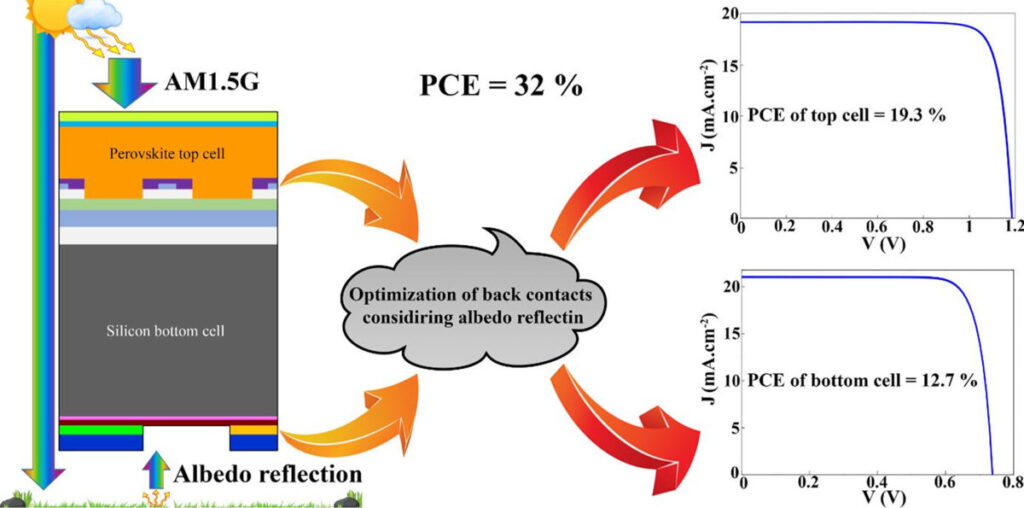A research team in Iran has designed a four-terminal perovskiet-silicon tandem solar cells with a 19.3%-efficient soil heterojunction cell and a 12.7%-efficient perovskiet top cell. Both subcels were conceived as subdivided back contacts, whereby the top cell is said to help improve the light of the tandem device and efficiency.
Researchers from the University of Tabriz in Iran have investigated the possibility of developing a 4-terminal (4T) bifacial perovskiet-silicon tandem solar cells in which configurations with interconnected contact (IBC) are used for both the upper and lower cells.
“In our work, the simultaneous optical and electrical optimization of IBC was carried out by the finite element method with regard to the non-ideality factors of recombination and manufacturing considerations,” the main author of the research, Amin Abbasiyan, told PV -Magazine. , Note that this is the first time that a bifacial perovskiet -silicon solar cell with a conventional soil heterojunction (HJT) device with IBCs is being investigated.
‘The IBC of the optimized top cell serves as a grater pinging and improves the lighting mechanism in the Perovskite top cell by introducing higher order-in-fractions, “he said:” It has been shown that the IBC configuration of the top cell is of the electrical characteristics “.
The scientists also explained that the geometric parameters of the IBC of the lower cell have been optimized to have the best performance under the Albedo Reflection, given the snow, sandstones, dry grass, concrete sand and asphalt surfaces, with the optimization of the soil cell under the Alcedo -Contension -Refrefection rust Textuur -Surfish and compensation of texture -surfish who reportedly improves the photocuroration and compensation of texture increases and compensation of texture increases that is reportedly improves, which is compensation for the soil cell, which contains the photocursation of texts and compensation of it -efficiency and compensation of it -efficiency and compensation of effects and compensation of effects and compensation of effects and compensation of it -efficiency and compensation of it -efficiency and compensation of it -efficiency and compensation and compensation and compensation and compensation and compensation and compensation and compensation and compensation and compensation and compensation and compensation and compensation and compensation and compensation and compensation and compensation. It is reportedly improving, which compensates for the soil cell, facilitates the manufacture of the solution-based perovskiet layer deposit on the top surface of the HJT floor cell.
The group designed the top perovskite cell with a substrate made of indium tin oxide (ITO), an electron transport layer (ETL) made of tin oxide (SnO2), a perovskite absorber, and a hole transport layer (HTL) made of nickel(II) oxide (NiOx) and an anti-reflecting coating doped with lithium Fluoride (lif).
A Transparent conductive oxide (TCO) Layer serves as the electrode of the upper cell that is the light of the upper cell in the lower and a 150 Nm thick tinoxide (SNO2) layer, is on the interfaces of two subcels and the electrode of the upper cell to prevent electrical compounds.
The simulations showed that, under average Albedo reflection, the lower cell can reach a power conversion -efficiency of 19.3%and the upper cell of 12.7%, with the tandem device achieving a total efficiency of up to 32%.
“It is the highest reported PCE for the 4T Bifacial Perovskiet-Silicon Tandem Solar cell, so far for the knowledge of the authors,” Said Abbasiyan.
It is also claimed that the proposed tandem cell configuration avoids the Tpyic instability factors for the perovskiet layer, which is very sensitive to contact deposits and thermal effects.
The cell concept was described in “Back contact optimization of both subcels in bifacial perovskiet/silicon tandem solar cell“Published in Renewable energy.
This content is protected by copyright and may not be reused. If you want to work with us and reuse part of our content, please contact: editors@pv-magazine.com.

